One of the beauties of the Princeton Offense is that there’s always a counter. It is said that “Princeton” has no beginning and no end. Point Spin is an example of this zen-like quality.
Point Series
At its core, the Princeton Offense is a series of two and three-player actions stemming from various shapes and linked together in different series or phases. One of those is the Point Series. Below is one of the possible ways the offense enters Point.
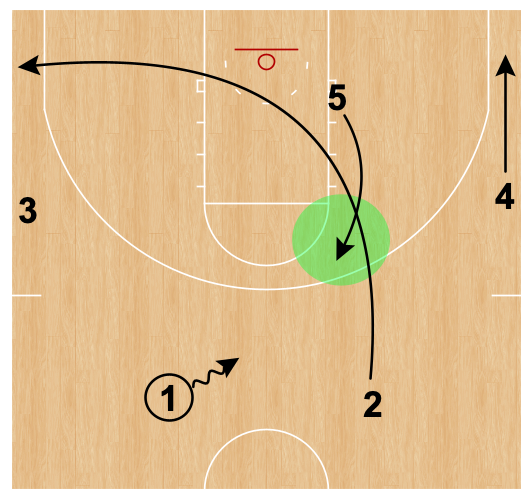
Above (Fig. 1) is the WAVE entry into Point Series where Player 1’s dribble “waves” Player 2 through on a BRUSH CUT. We want:
- Player 2 to cut behind his man
- and over the top of the post (Player 5)
This “brushes” Player 5 open in hopes that we can pass to them in the PINCH, the area in green circle. Once we enter to the PINCH various options are unlocked such as Point Over, Point Middle and Point Away.
But what if we cannot enter to Player 5 in the PINCH? The show must go on. The offense flows to SPIN.
Point Spin Introduction
Referring to Fig. 2 below, we want Player 1 to get to the midline with their dribble. When we enter the PINCH the preference is a one-hand bounce pass off the dribble. This passing technique allows us to keep our dribble in case Player 5 is unavailable.
Why would Player 5 be unavailable? Perhaps they are denied. This happens as the scouting report versus Princeton teams often reads, “keep the ball out of the high post.”
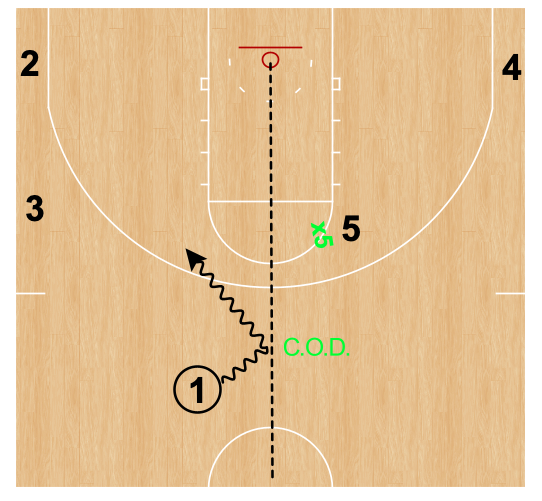
Another reason Player 5 may be unavailable – they are late arriving. If Player 1 gets to midline and Player 5 is not in the Pinch yet, don’t stop the offense to wait for them. Make a change of direction move (C.O.D.) and get us into spin. Remember, KEEP YOUR DRIBBLE!
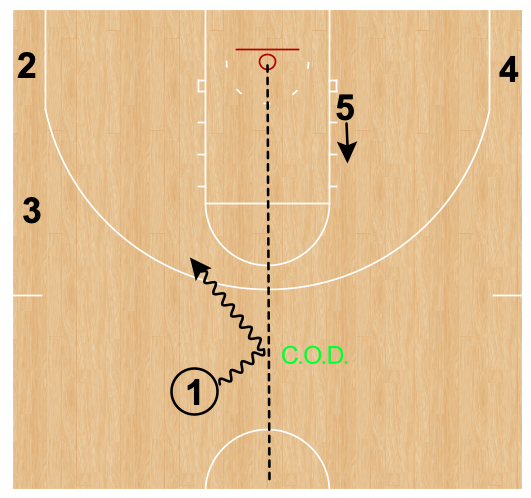
The SPIN option is unlocked when Player 1 surmises they cannot enter to Player 5 in the PINCH and they make a change of direction move (C.O.D.) such as a spin dribble, crossover, behind-the-back or between-the-legs.
Spin Details
Let’s run through the action after we’ve initiated SPIN with a C.O.D. move. The more Princeton Offense teams you study the more variations you’ll notice. Many of these variations have to do with personnel or the preferences of the coach.
In this piece we’ll detail the most common SPIN options starting with the dribble-at backdoor (Fig. 4 below).
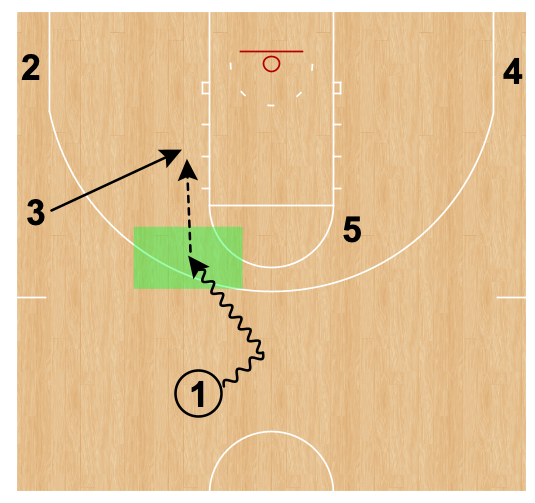
The hallmark of Princeton Offense is the dribble-at backdoor. In Fig. 4 above we see Player has triggered SPIN with the C.O.D. move at the midline. The dribble-at sends Player 3 on a backdoor cut. Player 1 delivers the one-hand bounce pass off the dribble. Tips:
- Player 3 wait for at least one bounce in your direction before cutting
- Player 3 step to “10 o’clock” to set up the backdoor cut, take your man one step higher
- Player 1 “punch the gap” with the dribble. Rather than dribbling wide at your teammate, punch the gap by dribbling at the low butt cheek of the defender
- The pass is early and trims the defender
- Throw the pass like “skipping rocks” on a pond
Again, it is important that we deliver the pass with one hand. Touching the ball with the off-hand thinking you are going to pass it then deciding not to kills the flow of the offense. Players must learn through drilling to throw bounce passes off the dribble with either hand.
Spin Variations
Next, something you will see many teams do when they don’t pass to the cutter for a backdoor layup is turning the back cut into a post up (Fig. 5 below).
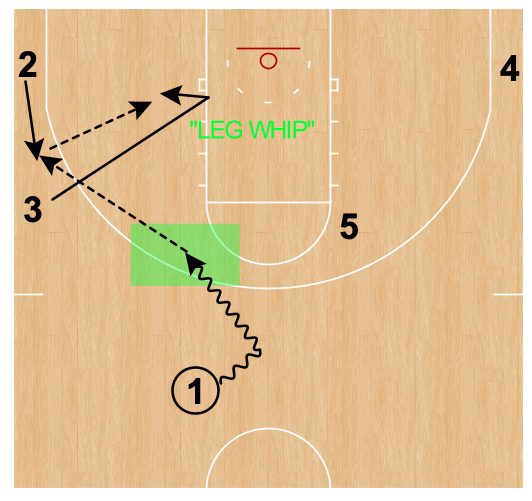
Player 1 makes the C.O.D. move at the midline and dribbles at Player 3 sending them on a back cut. If there is no bounce pass for the backdoor layup, Player 3 reverse pivots and “leg whips” their man into a post up.
Player 1 passes ahead to Player 2 who may enter into the post. This is an example of how the Princeton Offense allows you to utilize players other than your “post” in the post.
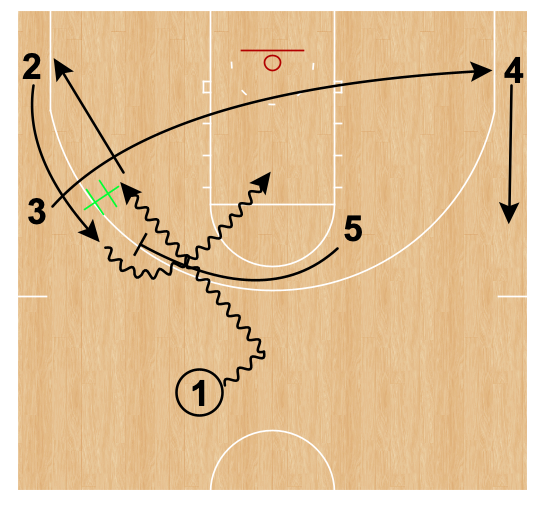
As mentioned, you will see variations across the Princeton landscape. In Fig. 6 above, we’ve diagrammed a variation of SPIN which features Pistol action. Pistol is a “modern” action that has be a part of the Princeton Offense for decades. In short, it is a handoff followed by a ball screen.
Above, Player 1 has gotten to the midline and taken it to SPIN with a C.O.D. move. Unlike the first variation where the cutter leg whipped into a post up, here the cutter just continues to the far corner.
Player 1 hands off to Player 2 then receives the ball screen from Player 5.
Many coaches are opting for fewer post ups and more open alignments. If this is you, then perhaps you’d prefer the Pistol option over the leg whip into a post up.
Conclusion
There are multiple ways to continue the offense from either of these options. They can link to CHIN Drift, or CHIN. Likewise, the Pistol option can lead to LOW POST.
Lastly, it is vital to know the counters when running the Princeton Offense. SPIN is not a call. It’s a reaction. As your team grows more familiar with them it will become second nature. Thus, teaching SPIN helps the offense remain on track when the high post is denied.
Video Assets
It helps to see SPIN in action. For that reason we’ve included three videos from our YouTube channel featuring three teams running Point Spin.
First, Division II powerhouse Alabama-Huntsville.
Second, the 2021 National Champion Stanford Cardinal Women’s Basketball squad.
Thirdly, Division III powerhouse Nebraska Wesleyan.
For help with implementation of these Princeton Offense concepts and learning more about what comes next, join our community for basketball coaches!
Enjoy all our basketball coaching resources.
Any questions, contact us! Happy to talk hoops any time day or night!
